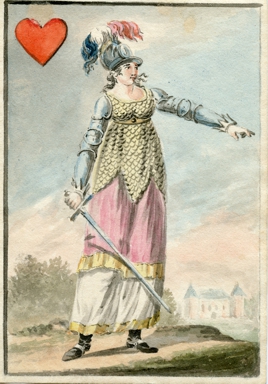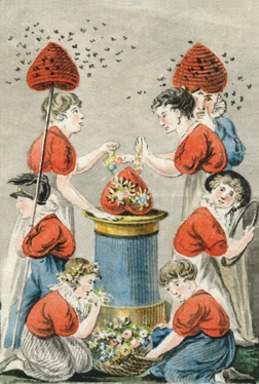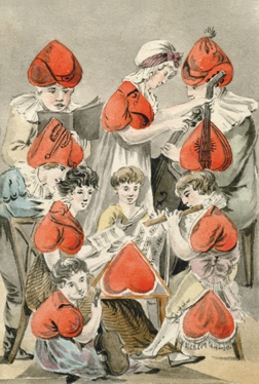 |
|
|
A DUTCH ORIGIN
Besides the most compelling evidence of the Dutch word on the 10 of clubs there are also a few other cards with a reference to Holland, all are court cards. There's the king of hearts, on which a famous Dutch admiral is pictured. Michiel Adriaenszoon de Ruyter lead the successful raid on the English fleet in Chatham during the Second Anglo-Dutch War in June 1667. The battle scene in the background probably refers to that voyage, known as the Raid on the Medway. On the ace of diamonds the Dutch flag waves over the fortification in the background. The soldier has a feather on his helmet in the Dutch colors. I've contacted the N.M.M. (National Military Museum) about the uniform of the soldier. They couldn't say which exact rank he held, but identified the uniform as that from the Batavian Republic (1795 - 1806) and Kingdom of Holland (1806 - 1810). They mentioned that the uniform had still been in use for a while after 1815 in the United Kingdom of the Netherlands (1815 - 1839). A similar colored feather is on the helmet of the figure on the queen of hearts. Here she is represented as the Dutch Maiden, the personification of the Netherlands.
 |
|
|
However, our Dutch Maiden looked familiar.
BORROWED INSPIRATION
I found 24 cards that were at least inspired by cards from one other transformation deck. I haven't found any cards that were inspired by cards from other transformation decks than from the Cotta deck from 1805. As you can see, our Dutch Maiden was clearly inspired by the figure of Isabeau de Baviere from that deck. I say inspired, because the overall design looks similar, but in detail there are plenty of differences. The lower part of the robe shows the artist's capability of creating a realistic difference in the gown. The QH is the only inspired court card, all the other courts have unique designs.
 |
|
Of course the main
difference is the technique. The Cotta deck was designed by the Countess
Charlotta von Jennison-Walworth and the cards were printed by stipple engraving on
copper. The original drawings of the Dutch transformation cards were done in
watercolor. That difference affects the outcome. It's much easier to do fine
details in the pointillist style with an etching needle than in watercolor with
a brush. Still, this unknown artist has succeeded to bring as much fine detail
in his designs as possible and the cards can be seen as small pieces of high
quality art. Another difference in the outcome is that almost all the pip cards
in the red suits were done in full color. In the Cotta deck the red suits are
printed in
gray tones with only the pips in red. In the black suits the artist shows his
skills in all the different gray tones.
Here "inspired by" will often mean that the overall composition was copied, but
that there are enough differences to be found. Only a few cards were almost
completely copied. In some designs creative differences consist of the
introduction of other objects and thus have led to a noticeable difference in
the complete scene. The 7 of hearts here below is a nice example of that. The
little boy at the right seems to have dozed off in the Cotta deck, but is
actively feeding his bird in this deck.
|
The 24 inspired cards are: |
Hearts 6, 7, 9,
10 and queen. Spades 2, 3, 4, 7, 8 and 9. Clubs 3, 4, 5, 7, 8, 9 and 10. Diamonds 2, 4, 5, 7, 9 and 10. |
|
I'll illustrate how the artist has used the Cotta cards to create his own cards by showing all 24 cards from both decks to compare. I'll leave you to draw your own conclusions. The images from the Cotta deck were supplied by Paul Symons. |
|
 |
|
 |
|
 |
|
 |
|
-1-
-2-
-3- -4-
-5- -6-
-7-
DXPOHOME